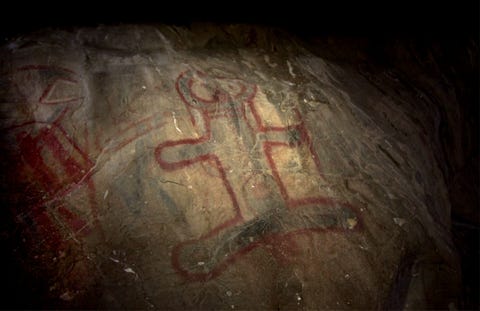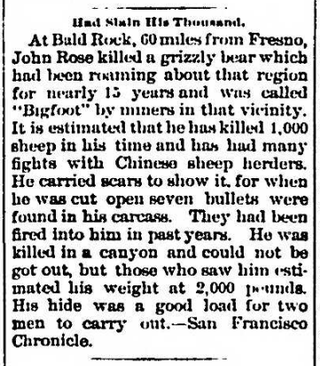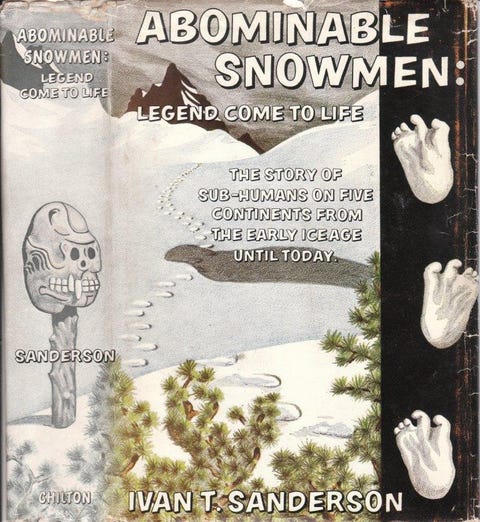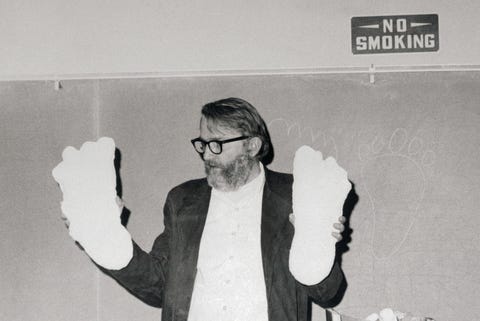#CRYPTOZOOLOGY #CRYPTID
Is Bigfoot Real? The Long Strange Story of Our Search for #Bigfoot
For centuries, people have reportedly seen this mythical primate-like animal in the woods of North America.
By Matt BlitzFeb 4, 2019
]
The film is mostly three-and-a-half minutes of grainy fall foliage, men riding horses, and jerky pans. The famous footage—used for decades afterward in every documentary about whether Bigfoot is real or fake—comes across as just someone having fun with their new camera. But, about two minutes in, the lens of a rented 16mm Cine Kodak camera catches something strange.
“We were just riding out alongside the creek, riding along enjoying the warm sunshine day,” says Bob Gimlin. “Then, across the creek, there was one standing. Everything happened so fast.”
What Gimlin's camera sees is a strange, large ape-like figure limbering on its hind legs across a clearing. For a brief moment, the animal appears to look directly at the camera, and, then, it’s gone. This is the famed Patterson–Gimlin film reportedly shot in October 1967 in the heavily wooded forests of Northern California, and it is one of the most heavily analyzed pieces of film in American history.
To some, this is definitive proof that Bigfoot is as real as mountain gorillas or narwhals. For others, it’s a hoax alongside videos claiming to show ghosts, aliens, and lizard people. But Gimlin knows exactly what he saw that day. “It walked upright and for quite a long ways. It didn’t look like a bear. I’ve been in the woods my whole life,” 86-year-old Gimlin tells Popular Mechanics. “There’s no doubt in my mind at all what it was.”
A Centuries-Old Tale

Pictographs at the Carrizo Plain National Monument belonging to the Yokut aboriginal tribe in Central California.
DAVID MCNEWGETTY IMAGES
This elusive, possibly fictitious animal goes by a number of different names—Bigfoot, Sasquatch, Yowie, Skunk Ape, Yayali—and for centuries, people across North America have had sightings.
Many Native American cultures have written oral legends that tell of a primate-type creature roaming the continent's forests. In these tales, the animals are sometimes more human-like and, other times, more ape-like. In the mythology of the Kwakiutl tribe that once heavily populated the western coast of British Columbia, Dzunukwa is a big, hairy female that lives deep in the mountainous forests]
]
“SOME TRIBES REALLY LOVE BIGFOOT…TO OTHER TRIBES THOUGH…HE’S AN ABSOLUTE ORGE, A MONSTER, AND SOMETHING BEST LEFT ALONE."
According to the legend, she spends most of her time protecting her children and sleeping, hence why she’s rarely seen. In fact, the name “Sasquatch” comes from Halkomelem, a language spoken by several First Nation peoples that occupied the upper Northwest into British Columbia.
In California, there are century-old pictographs drawn by the Yokuts that appear to show a family of giant creatures with long, shaggy hair. Called “Mayak datat” by the tribe, the image bears a resemblance to the commonly held vision of Bigfoot.
“Some tribes really love Bigfoot, they have a great relationship with him,” says Kathy Moskowitz Strain, author of the book Giants, Cannibals & Monsters: Bigfoot in Native Culture and archaeologist with the U.S. Forest Service. “To other tribes though, like the Miwoks, he’s an absolute orge, a monster, and something best left alone.”
To this day, Strain says, many of the tribesmen she does field research with believe that Bigfoot walks among us. “I’ve been in the field with tribal members where something strange happens and they always blame it on a Bigfoot,” says Strain.
There’s Bear Men in Them Hills

A still from the famous Patterson–Gimlin film, 1967.
BETTMANNGETTY IMAGES
Native Americans weren’t the only ones seeing this hairy, primate creature roaming the wilds of America. Nineteenth- and early 20th-century newspapers had whole sections devoted to the miners, trappers, gold prospectors, and woodsmen claiming to have seen “wild men,” “bear men,” and “monkey men.”
Most famously, in 1924, a group of prospectors hunkering down in a cabin along the shoulder of Mount St. Helen in Washington State claimed they were attacked late one night by a group of “ape-men.” Later, one of the prospectors admitted that they weren’t unprovoked attacks. He had taken potshots at the creatures earlier in the day.
Even then, as noted in Chad Arment’s 2006 book Historical Bigfoot, these accounts like the ones from the prospectors in 1924 were often regarded with a general sense of skepticism often due to the unreliable nature of the witnesses.

1895 article describing a grizzly bear with the nickname "Bigfoot."
PLACERVILLE MOUNTAIN DEMOCRATWIKIMEDIA COMMONS
“It’s hard to know what came out of the bottom of a whiskey bottle and what’s real,” says former NPR producer Laura Krantz, who’s a host of the new podcast Wild Thing, which digs deep into the search for Bigfoot.
There were also times when one animal was confused for another, possibly explaining the origin of the name “Bigfoot.” Newspaper accounts show that “Bigfoot” was a common nickname for particularly large, aggressive grizzly bears who ate cattle, sheep, and attacked humans. It wasn’t until 1958 when a California tractor operator named Jerry Crew “found” a series of huge muddy footprints that the term was popularized in reference to the primate-like animals.
That same year, another man named Ray Wallace also said he had discovered large prints belonging to Bigfoot. Upon his death in 2002, it was revealed that this was a hoax.
Sasquatch Goes Mainstream

KEVIN SCHAFERGETTY IMAGES
It was in the mid 20th century when Bigfoot stepped from local lore to national phenomenon.
In 1961, naturalist Ivan T. Sanderson published his book Abominable Snowmen: Legend Come to Life. In the book, Sanderson uses footprints, eye witnesses, and bone samples as potential evidence of “sub-humans” living on five continents across the world, including North America’s Sasquatch and the Himalayas’ Yeti (though others believe that the Yeti is a totally different species).
Sanderson’s work caught enough people’s attention that William Straus, a well-regarded primate evolutionary biologist at John Hopkins University, reviewed it for Science Magazine, saying Sanderson’s standards for evidence are “unbelievably low” and that the evidence is “anything but convincing.”
Nonetheless, Strauss admits it would be foolish and quite unscientific to say that the creatures Sanderson describes absolutely don’t exist.

Original cover of Ivan T. Sanderson’s book Abominable Snowman: Legend Come To Life.
CHILTON
Sanderson’s book was followed by the Patterson–Gimlin film six years later. Gimlin says it happened so fast that he considers himself and Roger Patterson pretty lucky that they were able to get any footage at all of the hairy, mythical animal lumbering along only yards away from them.
When he watched the footage for the first time a few days later, Gimlin was pretty pessimistic that this would be enough to convince anyone. “I didn’t think the film was that good. I saw it [with my two eyes] better than that,” says Gimlin. Yet, it became a phenomenon.
Some, like former director of the primate biology program at the Smithsonian Institution John Napier, saw it as a well-done, elaborate hoax. But not everyone saw it that way, including Grover Krantz.
A professor of physical anthropology at Washington State University and “a leading authority in hominoid evolution” and primate bone structures, Krantz also believed in Sasquatch. His unwavering belief came from eyewitnesses, the creature’s gait in the Patterson–Gimlin film, and, most importantly, the anatomical structure of found footprints. It was the dermal ridges, where sweat pores open on palms and soles, depicted in the prints that left him convinced that at least some were authentic.
His working theory was that Sasquatch was part of the hominid family, the same one humans shared with apes, and was a descendant of thought-to-be-long-extinct humongous primate species that once lived in Asia appropriately named Gigantopithecus. At some point, million of years ago, it had crossed the Bering Strait when it was still a land bridge into North America and evolved into its own species on this continent.
“Grover was eclectic. That’s a good word describe him,” says Jeff Meldrum, author of the book Sasquatch: Legend Meets Science, a professor of anatomy at Idaho State University, and a one-time colleague of Krantz’s. “There were many ideas that he had that were a decade or two ahead of his time and…when he pursued some of these ideas, he would be ridiculed.”
When asked about the possibility of Sasquatch existing, Krantz was always unequivocal, saying that he “guaranteed” it.
Family Ties

Grover Krantz with casts of footprints supposedly belonging to Sasquatch, 1974.
BETTMANNGETTY IMAGES
Krantz’s conviction in Bigfoot didn’t help his academic career, though. Passed over for promotions and nearly missing receiving tenure at Washington State, he knew the only way he would be able to convince his colleagues of this primate’s existence was by producing a body.
So, Krantz was known to spend his nights in the middle of the Pacific Northwest old growth forests with a shotgun quite literally hunting Bigfoot. He rationalized this by saying it was the only way to get the scientific community to believe him and that, technically, it wasn’t against the law.
“It has not yet been established that the Sasquatch exists,” Krantz once wrote. “To pass laws against harming sasquatches presently makes little more sense than protecting unicorns.”
“THE KIND OF REAL PROOF THAT WOULD ACTUALLY MAKE PEOPLE SIT UP AND TAKE NOTICE DOESN’T ACTUALLY EXIST AT THIS POINT."
Krantz died in 2002 as a complex figure in the eyes of the scientific community, highly respected for his work in primate evolution yet mocked for his belief in Bigfoot. However, during Krantz’s life and after it, the search for Bigfoot took on a life of its own. More sightings, films, and books, some from respected researchers, emerged. Bigfoot documentaries captured the public’s imagination. Harry lived with the Hendersons and entertained the masses. Even Jane Goodall, the famed chimpanzee expert, admits that there’s a possibility that a undiscovered large primate may exist in the world.
In 2006, Laura Krantz, at the time an NPR reporter based in D.C., read an article about the quirky anthropologist who shared her last name. “It originally didn’t ring any bells…he just seemed like an eccentric weirdo.
But, then, she saw that he was also from Salt Lake City, like her father’s family—they were related. As Krantz’s grandfather told her at the time, “Oh, yeah. Grover. That was my cousin. He used to come to the family picnics and measure people’s heads with a caliper.” This began Krantz’s own journey into the wilderness in search of Bigfoot, which she documented for her new podcast Wild Thing, which aired its first episode on October 2, 2018.
She acknowledges, much like her cousin Grover, that without a body (or skeleton), it’s hard to convince others that this long-lost primate still exists in North America’s backwoods. “A lot of people who think Bigfoot is out there, they realize…that there’s a lack of evidence,” says Krantz. “The kind of real proof that would actually make people sit up and take notice doesn’t actually exist at this point.”
But the things she’s observed during her research for the podcast has changed her mind about the possibility of Bigfoot.
“I went from ‘Bigfoot is a legend’ to I can’t just say out of hand that Bigfoot never existed or doesn’t exist now,” says Krantz. “I can’t fully dismiss it anymore.”
[Related: The FBI Just Released Bigfoot's Official File]
“SOME TRIBES REALLY LOVE BIGFOOT…TO OTHER TRIBES THOUGH…HE’S AN ABSOLUTE ORGE, A MONSTER, AND SOMETHING BEST LEFT ALONE."
According to the legend, she spends most of her time protecting her children and sleeping, hence why she’s rarely seen. In fact, the name “Sasquatch” comes from Halkomelem, a language spoken by several First Nation peoples that occupied the upper Northwest into British Columbia.
In California, there are century-old pictographs drawn by the Yokuts that appear to show a family of giant creatures with long, shaggy hair. Called “Mayak datat” by the tribe, the image bears a resemblance to the commonly held vision of Bigfoot.
“Some tribes really love Bigfoot, they have a great relationship with him,” says Kathy Moskowitz Strain, author of the book Giants, Cannibals & Monsters: Bigfoot in Native Culture and archaeologist with the U.S. Forest Service. “To other tribes though, like the Miwoks, he’s an absolute orge, a monster, and something best left alone.”
To this day, Strain says, many of the tribesmen she does field research with believe that Bigfoot walks among us. “I’ve been in the field with tribal members where something strange happens and they always blame it on a Bigfoot,” says Strain.
There’s Bear Men in Them Hills

A still from the famous Patterson–Gimlin film, 1967.
BETTMANNGETTY IMAGES
Native Americans weren’t the only ones seeing this hairy, primate creature roaming the wilds of America. Nineteenth- and early 20th-century newspapers had whole sections devoted to the miners, trappers, gold prospectors, and woodsmen claiming to have seen “wild men,” “bear men,” and “monkey men.”
Most famously, in 1924, a group of prospectors hunkering down in a cabin along the shoulder of Mount St. Helen in Washington State claimed they were attacked late one night by a group of “ape-men.” Later, one of the prospectors admitted that they weren’t unprovoked attacks. He had taken potshots at the creatures earlier in the day.
Even then, as noted in Chad Arment’s 2006 book Historical Bigfoot, these accounts like the ones from the prospectors in 1924 were often regarded with a general sense of skepticism often due to the unreliable nature of the witnesses.

1895 article describing a grizzly bear with the nickname "Bigfoot."
PLACERVILLE MOUNTAIN DEMOCRATWIKIMEDIA COMMONS
“It’s hard to know what came out of the bottom of a whiskey bottle and what’s real,” says former NPR producer Laura Krantz, who’s a host of the new podcast Wild Thing, which digs deep into the search for Bigfoot.
There were also times when one animal was confused for another, possibly explaining the origin of the name “Bigfoot.” Newspaper accounts show that “Bigfoot” was a common nickname for particularly large, aggressive grizzly bears who ate cattle, sheep, and attacked humans. It wasn’t until 1958 when a California tractor operator named Jerry Crew “found” a series of huge muddy footprints that the term was popularized in reference to the primate-like animals.
That same year, another man named Ray Wallace also said he had discovered large prints belonging to Bigfoot. Upon his death in 2002, it was revealed that this was a hoax.
Sasquatch Goes Mainstream

KEVIN SCHAFERGETTY IMAGES
It was in the mid 20th century when Bigfoot stepped from local lore to national phenomenon.
In 1961, naturalist Ivan T. Sanderson published his book Abominable Snowmen: Legend Come to Life. In the book, Sanderson uses footprints, eye witnesses, and bone samples as potential evidence of “sub-humans” living on five continents across the world, including North America’s Sasquatch and the Himalayas’ Yeti (though others believe that the Yeti is a totally different species).
Sanderson’s work caught enough people’s attention that William Straus, a well-regarded primate evolutionary biologist at John Hopkins University, reviewed it for Science Magazine, saying Sanderson’s standards for evidence are “unbelievably low” and that the evidence is “anything but convincing.”
Nonetheless, Strauss admits it would be foolish and quite unscientific to say that the creatures Sanderson describes absolutely don’t exist.

Original cover of Ivan T. Sanderson’s book Abominable Snowman: Legend Come To Life.
CHILTON
Sanderson’s book was followed by the Patterson–Gimlin film six years later. Gimlin says it happened so fast that he considers himself and Roger Patterson pretty lucky that they were able to get any footage at all of the hairy, mythical animal lumbering along only yards away from them.
When he watched the footage for the first time a few days later, Gimlin was pretty pessimistic that this would be enough to convince anyone. “I didn’t think the film was that good. I saw it [with my two eyes] better than that,” says Gimlin. Yet, it became a phenomenon.
Some, like former director of the primate biology program at the Smithsonian Institution John Napier, saw it as a well-done, elaborate hoax. But not everyone saw it that way, including Grover Krantz.
A professor of physical anthropology at Washington State University and “a leading authority in hominoid evolution” and primate bone structures, Krantz also believed in Sasquatch. His unwavering belief came from eyewitnesses, the creature’s gait in the Patterson–Gimlin film, and, most importantly, the anatomical structure of found footprints. It was the dermal ridges, where sweat pores open on palms and soles, depicted in the prints that left him convinced that at least some were authentic.
His working theory was that Sasquatch was part of the hominid family, the same one humans shared with apes, and was a descendant of thought-to-be-long-extinct humongous primate species that once lived in Asia appropriately named Gigantopithecus. At some point, million of years ago, it had crossed the Bering Strait when it was still a land bridge into North America and evolved into its own species on this continent.
“Grover was eclectic. That’s a good word describe him,” says Jeff Meldrum, author of the book Sasquatch: Legend Meets Science, a professor of anatomy at Idaho State University, and a one-time colleague of Krantz’s. “There were many ideas that he had that were a decade or two ahead of his time and…when he pursued some of these ideas, he would be ridiculed.”
When asked about the possibility of Sasquatch existing, Krantz was always unequivocal, saying that he “guaranteed” it.
Family Ties

Grover Krantz with casts of footprints supposedly belonging to Sasquatch, 1974.
BETTMANNGETTY IMAGES
Krantz’s conviction in Bigfoot didn’t help his academic career, though. Passed over for promotions and nearly missing receiving tenure at Washington State, he knew the only way he would be able to convince his colleagues of this primate’s existence was by producing a body.
So, Krantz was known to spend his nights in the middle of the Pacific Northwest old growth forests with a shotgun quite literally hunting Bigfoot. He rationalized this by saying it was the only way to get the scientific community to believe him and that, technically, it wasn’t against the law.
“It has not yet been established that the Sasquatch exists,” Krantz once wrote. “To pass laws against harming sasquatches presently makes little more sense than protecting unicorns.”
“THE KIND OF REAL PROOF THAT WOULD ACTUALLY MAKE PEOPLE SIT UP AND TAKE NOTICE DOESN’T ACTUALLY EXIST AT THIS POINT."
Krantz died in 2002 as a complex figure in the eyes of the scientific community, highly respected for his work in primate evolution yet mocked for his belief in Bigfoot. However, during Krantz’s life and after it, the search for Bigfoot took on a life of its own. More sightings, films, and books, some from respected researchers, emerged. Bigfoot documentaries captured the public’s imagination. Harry lived with the Hendersons and entertained the masses. Even Jane Goodall, the famed chimpanzee expert, admits that there’s a possibility that a undiscovered large primate may exist in the world.
In 2006, Laura Krantz, at the time an NPR reporter based in D.C., read an article about the quirky anthropologist who shared her last name. “It originally didn’t ring any bells…he just seemed like an eccentric weirdo.
But, then, she saw that he was also from Salt Lake City, like her father’s family—they were related. As Krantz’s grandfather told her at the time, “Oh, yeah. Grover. That was my cousin. He used to come to the family picnics and measure people’s heads with a caliper.” This began Krantz’s own journey into the wilderness in search of Bigfoot, which she documented for her new podcast Wild Thing, which aired its first episode on October 2, 2018.
She acknowledges, much like her cousin Grover, that without a body (or skeleton), it’s hard to convince others that this long-lost primate still exists in North America’s backwoods. “A lot of people who think Bigfoot is out there, they realize…that there’s a lack of evidence,” says Krantz. “The kind of real proof that would actually make people sit up and take notice doesn’t actually exist at this point.”
But the things she’s observed during her research for the podcast has changed her mind about the possibility of Bigfoot.
“I went from ‘Bigfoot is a legend’ to I can’t just say out of hand that Bigfoot never existed or doesn’t exist now,” says Krantz. “I can’t fully dismiss it anymore.”
[Related: The FBI Just Released Bigfoot's Official File]
No comments:
Post a Comment